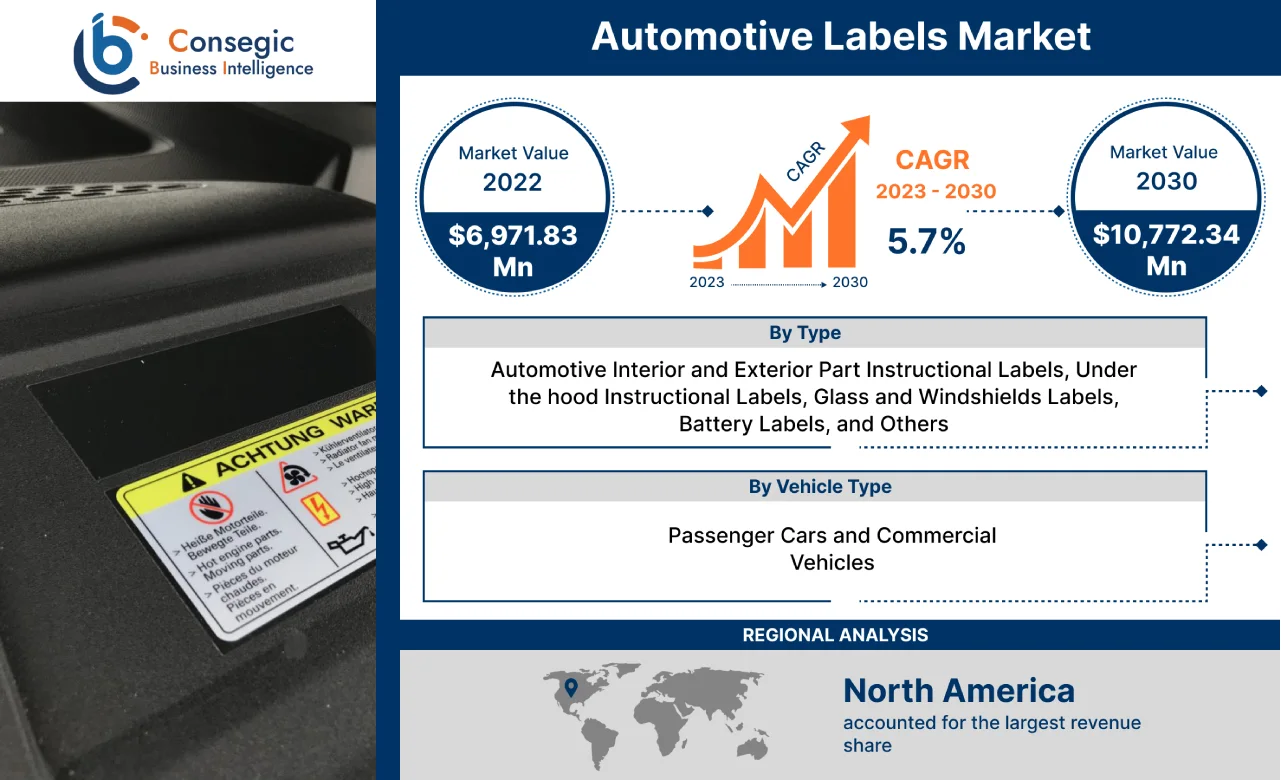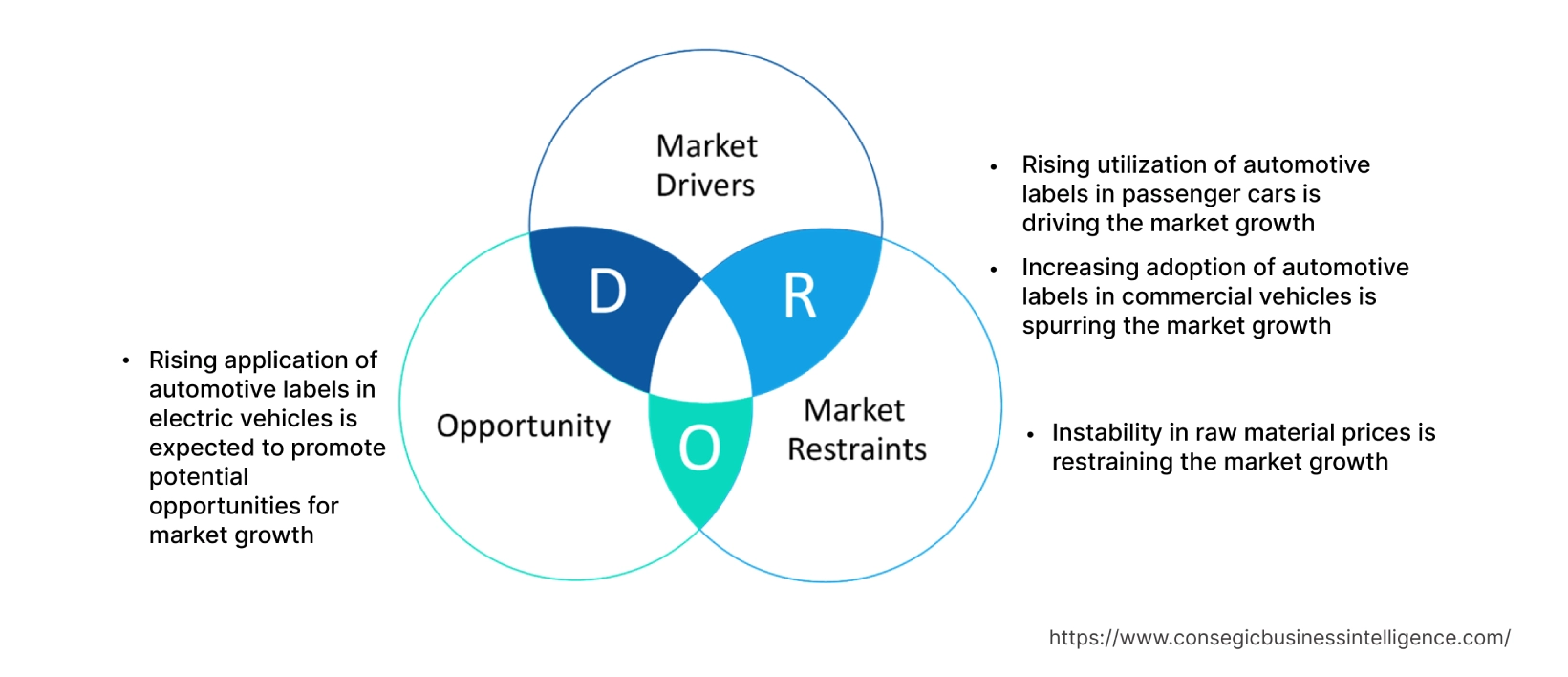- Summary
- Table Of Content
- Methodology
Automotive Labels Market Introduction :
Automotive Labels Market size is estimated to reach over USD 10,772.34 Million by 2030 from a value of USD 6,971.83 Million in 2022, growing at a CAGR of 5.7% from 2023 to 2030.
Automotive Labels Market Definition & Overview :
Automotive labels mostly comprise badging and labels, including barcodes, VIN labels, and others that are designed for displaying component information, the company's name and logo, technical information, price, and other vital details. These offer a range of benefits including increased efficiency throughout the supply chain, enhanced accuracy of inventory scanning, tracking item location along offering relevant information regarding the safe handling of automobiles. Based on the market trends analysis, the aforementioned benefits of these are key determinants for increasing its utilization in passenger cars and commercial vehicles, among others.
Automotive Labels Market Insights :
Key Drivers :
The rising utilization of automotive labels in passenger cars is driving the automotive labels market.
Automotive labels are primarily utilized in various components of passenger cars including the car battery, windshield, tire, and other interior and exterior parts of the car. These labels including safety labels and instruction labels are usually deployed in passenger cars to provide users with relevant information regarding the safe handling and use of automobiles. According to the analysis, factors including rising disposable income, increasing passenger car production, and growing integration of safety and instruction labels in cars are among the key prospects driving the market growth of these labels.
- According to the OICA (International Organization of Motor Vehicle Manufacturers), the total production of passenger cars in the Asia-Pacific region reached 42,324,447 units in 2022, witnessing an increase of nearly 11% in comparison to 38,188,956 units in 2021.
Hence, the rising production of passenger cars is driving the adoption of these, in turn proliferating the automotive labels market growth.
The increasing adoption of automotive labels in commercial vehicles is spurring the market.
An automotive label is critical of commercial vehicles. They are used in various interior and exterior components of the commercial vehicle including batteries, tires, windshields, vehicle under hood, and others. The deployment of these labels in the commercial vehicle helps in providing technical information, component information, and other vital details associated with the safety and utilization of the vehicle. As per the analysis, factors including the growing pace of industrialization, increasing investments in commercial vehicles, and the rising need for cost-effective modes of transportation and logistics are key determinants driving the rise of commercial vehicles.
- According to the International Organization of Motor Vehicle Manufacturers, the overall production of light commercial vehicles in North America reached 11,567,376 units in 2022, depicting a rise of 18.5% as compared to 9,763,494 units in 2020.
Thus, the growing commercial vehicles sector is further driving the adoption of these labels for aforementioned applications, in turn driving the automotive labels market demand.
Key Restraints :
Instability in raw material prices is restraining the market growth
The overall cost of automotive labels is dependent on the cost of production, followed by the cost of raw materials including polymers and plastic including polypropylene, polyvinyl chloride, polyester, polycarbonate, polyethylene terephthalate, and others. As a result, fluctuations in the prices of raw materials impact the overall cost of these labels, which is a prime factor restricting the market.
- For instance, SNF LTD increased its price of polymers in September 2022, owing to the rising impact of supply chain issues on the overall production costs of the company. Additionally, global polyethylene terephthalate prices surged by 43% in FY 2021-22, attributed to supply chain disruptions due to plant shutdowns in the U.S. and Europe during the pandemic.
Hence, the analysis of market trends shows that the instability in prices of raw materials that are used in the production of these labels is restraining the market.
Future Opportunities :
The rising application of automotive labels in electric vehicles is expected to promote potential opportunities for market growth.
The rising application of automotive labels in electric vehicles (EVs) is expected to present potential opportunities for the automotive label market. These labels including instruction labels, safety labels, and others are often employed in electric vehicles to provide component information, technical information, and other crucial information related to the safety and the use of electric vehicles. Factors such as the availability of a wide range of models, eco-friendliness, and the availability of tax rebates and subsidies are driving the demand for electric vehicles. Additionally, governments across the world are taking initiatives and framing policies to reduce pollution and increase the deployment of electric vehicles, which is further anticipated to stimulate the adoption of EVs.
- For instance, purchase incentives and tax benefits for electric vehicles including electric bikes are available in 21 countries listed in the European Union including Austria, Netherlands, Belgium, Spain, Poland, and other countries as of 2022.
- According to the European Environment Agency, electric car registrations in Europe reached around 1.73 million units in 2021, witnessing a significant increase of around 63% in comparison to 1.06 million units in 2020.
Therefore, the rising adoption of electric vehicles is projected to increase the integration of these in EVs, in turn promoting opportunities for the market and influencing automotive labels market trends during the forecast period.
Automotive Labels Market Report Insights :
| Report Attributes | Report Details |
| Study Timeline | 2017-2030 |
| Market Size in 2030 | USD 10,772.34 Million |
| CAGR (2023-2030) | 5.7% |
| Based on the Type | Automotive Interior and Exterior Part Instructional Labels, Under the hood Instructional Labels, Glass and Windshields Labels, Battery Labels, and Others |
| Based on the Vehicle Type | Passenger Cars and Commercial Vehicles |
| Based on the Region | North America, Europe, Asia-Pacific, Latin America, and Middle East & Africa |
| Key Players | 3M, Avery Dennison Corporation, Resource Label Group, Brady Corporation, UPM, Polyonics, ImageTek Labels, Weber Packaging Solutions, Advantage Labeling & Packaging Inc., Clarion Safety Systems, Multi-Color Corporation, and LKQ Corporation |
Automotive Labels Market Segmental Analysis :
Based on the Type :
Based on the type, the market is divided into automotive interior and exterior part instructional labels, under-the-hood instructional labels, glass and windshield labels, battery labels, and others.
The automotive interior and exterior part instructional labels segment accounted for the largest revenue share of 41.2% of the total automotive labels market share in the year 2022. The automotive interior and exterior part instructional labels are among the most crucial types of labels used in automobiles. Automotive interior and exterior part instructional labels help vehicle users operate the vehicle and maintain the interior and exterior automobile parts. As per the analysis, most automotive interior and exterior part instructional labels are simple, informative, and provide relevant information regarding the handling and operation of automobiles. The above characteristics of automotive interior and exterior part instructional labels are increasing their utilization in passenger cars and commercial vehicles.
- According to the International Organization of Motor Vehicle Manufacturers, the total production of passenger cars in South America reached 2,133,793 units in 2022, depicting a rise of 10% in comparison to 2021.
Hence, the rise in passenger car production is among the key factors driving the application of automotive interior and exterior part instructional labels in passenger cars, in turn contributing to the rise of the market.
The battery labels segment is anticipated to register the fastest CAGR share during the forecast period. Automotive battery labels include information associated with voltage, cranking amps, reserve capacity, amp hours, deep cycle, and others. Moreover, battery labels offer several features such as high durability and strength, chemical resistance, and long shelf-life, which makes them ideal for utilization in passenger cars, commercial vehicles, and electric vehicles.
- According to the International Organization of Motor Vehicle Manufacturers, the total automobile production in the North American region reached 14,798,146 units in 2022, depicting an increase of nearly 10% from 13,467,065 units in 2021.
Thus, the rising automobile production is fostering the demand for automotive battery labels for providing relevant technical information related to vehicle batteries, in turn driving the automotive labels market trends during the forecast period.
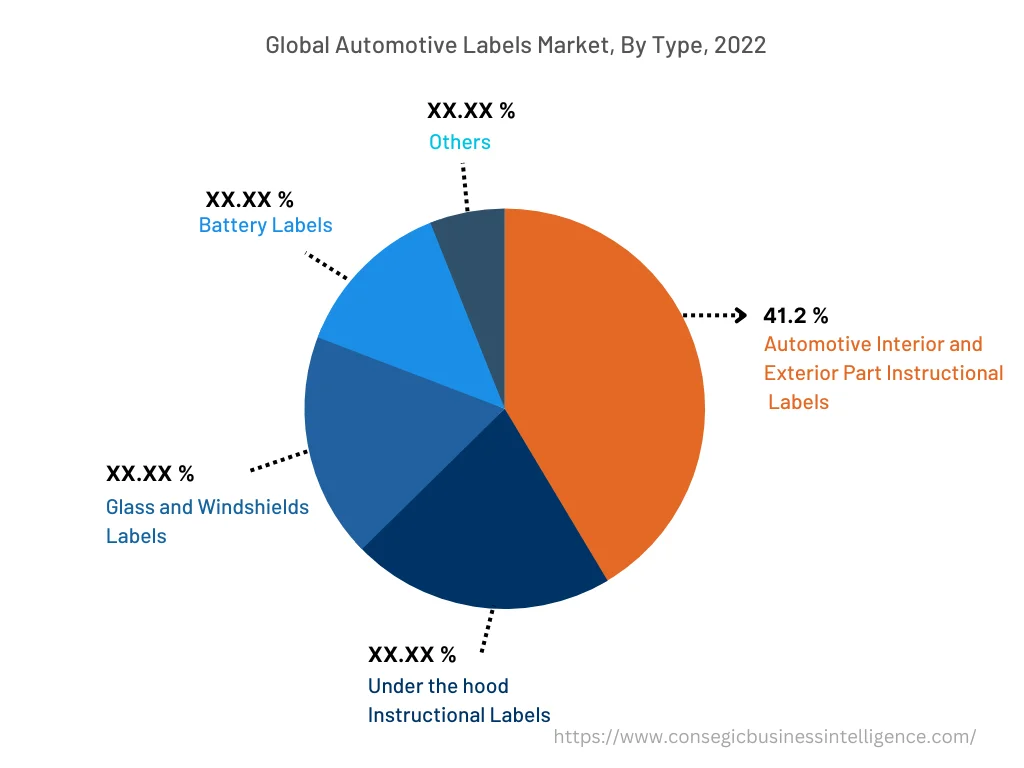
Based on the Vehicle Type :
Based on the vehicle type, the market is bifurcated into passenger cars and commercial vehicles.
The passenger cars segment accounted for the largest automotive labels market share in the year 2022. Factors such as rising disposable income, increasing passenger car production, and growing integration of safety and instruction labels in cars are among the key prospects driving the rise of the passenger car segment.
- According to ACEA (European Automobile Manufacturers Association), the total production of passenger cars in the European Union reached up to 10.9 million in 2022, depicting a rise of 8.3% in comparison to 2021.
Therefore, the automotive labels market analysis shows that the rising production of passenger cars is driving the utilization of these labels in various components of passenger cars including the car battery, windshield, tire, and other interior and exterior parts of the car, in turn fostering market trends during the forecast period.
The commercial vehicle segment is expected to witness the fastest CAGR during the forecast period. The rise of the commercial vehicle segment is attributed to several factors including the rising pace of industrialization, increasing investments in commercial vehicles, and rising demand for cost-effective modes of transportation and logistics.
- For instance, according to the Society of Indian Automobile Manufacturers, the total production of commercial vehicles in India has reached 10,35,626 units from April 2022 to March 2023, representing an increase of 28.6% from 8,05,527 units from April 2021 to March 2022.
Therefore, the analysis of segmental trends depicts that the growing commercial vehicles sector is driving the automotive labels market demand.
Based on the Region :
The regional segment includes North America, Europe, Asia Pacific, the Middle East and Africa, and Latin America.
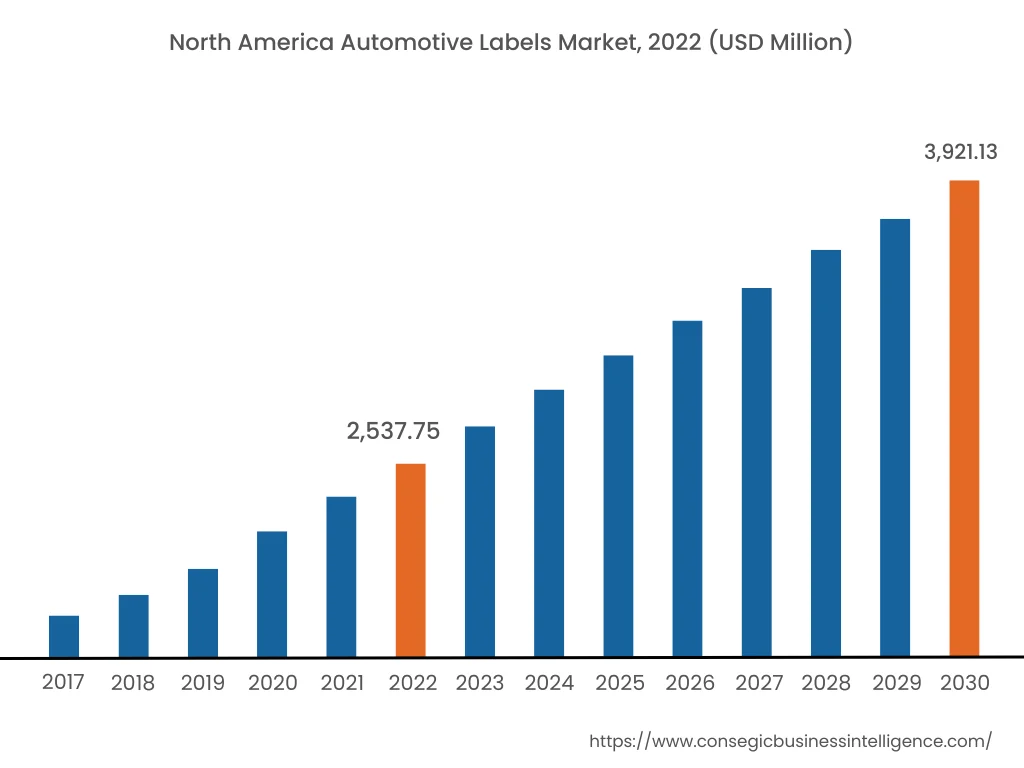
North America accounted for the largest revenue share of USD 2,537.75 Million in 2022 and is expected to reach USD 3,921.13 Million by 2030, registering a CAGR of 5.7% during the forecast period. In addition, in the region, the U.S. accounted for the maximum revenue share of 53.4% in the same year. The adoption of these labels in North America is primarily driven by multiple factors including growing investment trends in the expansion of automobile manufacturing facilities and rising automotive production in the region.
- For instance, according to the International Organization of Motor Vehicle Manufacturers, the total automobile production in Canada reached 1.2 million in 2022, representing a rise of 10% in comparison to 2021.
Based on the automotive labels market analysis, the above factors are further propelling the market growth in the North American region. Additionally, the rising adoption of electric vehicles in the region is anticipated to provide lucrative rise aspects for the market in North America during the forecast period.
Asia-Pacific is expected to register the fastest CAGR of 6.1% during the forecast period. The rapid pace of industrialization and development is creating lucrative automotive labels market opportunities in the forecast year. Moreover, factors including the growing pace of urbanization, increasing government investments in the automotive sector, and rising automobile production are stimulating the market growth for automotive labels in the Asia-Pacific region.
- For instance, according to the Society of Indian Automobile Manufacturers, the total automotive production in India reached 2,59,31,867 units from April 2022 to March 2023, depicting a substantial rise of 12.6% from 2,30,40,066 units from April 2021 to March 2022.
Therefore, the regional trends conclude that the rise in automobile production is driving the deployment of these labels, in turn proliferating the automotive labels market growth in the Asia-Pacific region.
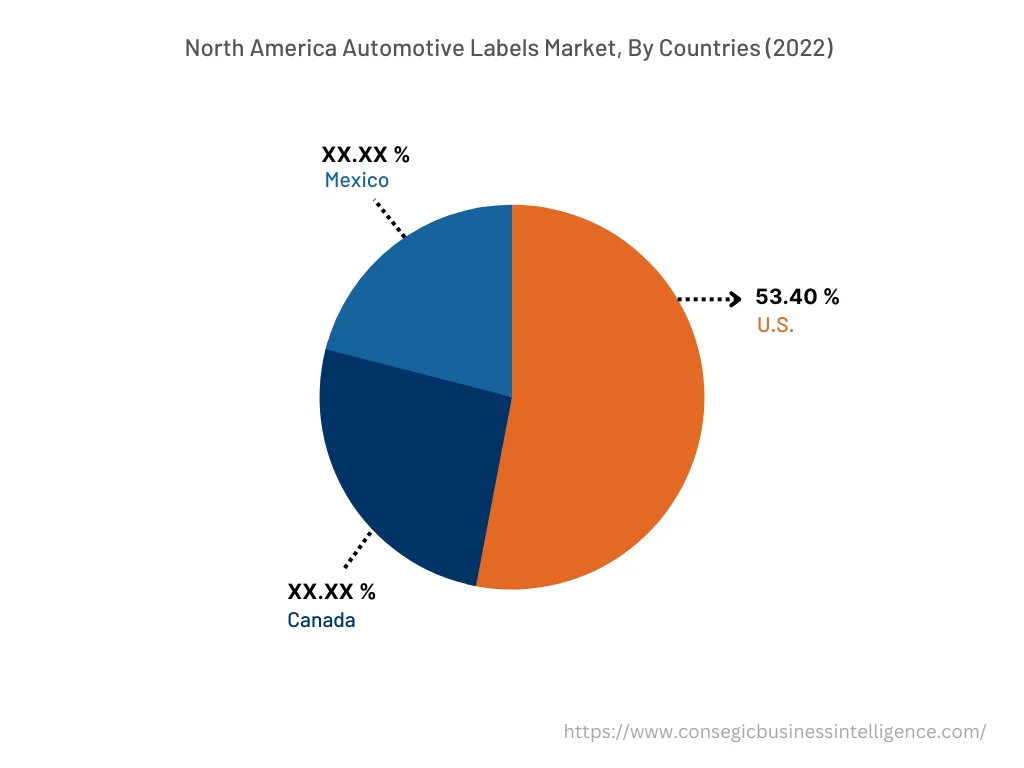
Top Key Players & Market Share Insights :
The automotive labels market is highly competitive with major players providing these labels to the national and international markets. Key players are adopting several strategies in research and development (R&D), product innovation, and application launches to hold a strong position in the global automotive labels market. Key players in the automotive labels industry include-
- 3M
- Resource Label Group
- UPM
- ImageTek Labels
- Ga International
- Advantage Labeling & Packaging Inc.
- Multi-Color Corporation
- Avery Dennison Corporation
- Brady Corporation
- Polyonics
- Weber Packaging Solutions
- Clarion Safety Systems
- LKQ Corporation
Recent Industry Developments :
- In November 2022, Multi-Color Corporation (MCC), acquired Flexcoat Autoadesivos S.A., headquartered in Brazil. The main motive for the acquisition was to add Flexcoat's lamination and label operations to MCC's existing product portfolio. Flexcoat's labels are used in various industries including food and beverage, pharmaceutical, automotive, and others.
Key Questions Answered in the Report
What is automotive label? +
Automotive labels mostly comprise of badging and labels, including barcodes, VIN labels, and others that are designed for displaying component information, company's name and logo, technical information, price, and other vital details.
What specific segmentation details are covered in the automotive label report, and how is the dominating segment impacting the market growth? +
By type segment has witnessed automotive interior and exterior part instructional labels as the dominating segment in the year 2022, owing to its increasing utilization in passenger cars and commercial vehicles.
What specific segmentation details are covered in the automotive label market report, and how is the fastest segment anticipated to impact the market growth? +
By vehicle type segment has witnessed commercial vehicles as the fastest-growing segment during the forecast period due to the rising adoption of automotive labels in commercial vehicles for providing technical information, safety information, and other vital details associated with the utilization of the vehicle.
Which region/country is anticipated to witness the highest CAGR during the forecast period, 2023-2030? +
Asia-Pacific is anticipated to register fastest CAGR growth during the forecast period due to rapid pace of industrialization, increasing government investments in the automotive sector, and rising automobile production.
